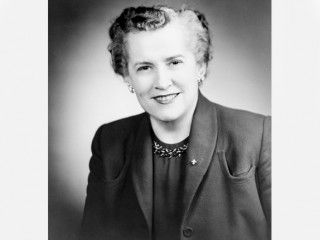
Edith Green biography
Date of birth : 1910-01-17
Date of death : 1987-04-21
Birthplace : Trent, South Dakota, U.S.
Nationality : American
Category : Politics
Last modified : 2011-03-05
Credited as : Politician, congresswoman, U.S. House of Representatives
A U.S. congresswoman from Oregon from 1954 to 1974, Edith Starrett Green worked vigorously for improved education and educational opportunity and for women's rights.
Edith Starrett Green was born January 17, 1910, in Trent, South Dakota, to James and Julia Starrett, who soon moved to Oregon. By 1930 she began a teaching career which was interrupted when she married businessman Arthur N. Green and had a family.
Although a daughter of two school teachers, Edith Starrett had preferred to be a lawyer or engineer. However, others persuaded her to pursue a more conventional woman's profession. She earned a Bachelor's degree from the University of Oregon in 1939 and did graduate work at Stanford University. In the 1940s she was a free-lance writer and radio commentator, but her interest in education continued and she served as a state lobbyist for education groups.
A life-long Democrat, she first ran for political office in 1952 and, although she lost, it provided valuable exposure for her next race. In 1954 she won Oregon's Third Congressional House seat in the closest race of her career. Thereafter, she captured at least 63 percent of all general election votes in nine subsequent elections.
As the second woman to represent Oregon in its history, Green became one of only 17 women then in the U.S. House of Representatives. Acting on her 1954 slogan that "Education should be the number one business in this country," Green became known as "Mrs. Education" and "Mother of Affirmative Action" for her role in legislation which vitally affected federal aid to education and women's rights.
In her first congressional term Green introduced the Library Service Bill which provided access to libraries for millions of persons in rural areas. Her imprint was on the National Defense Education Act of 1958, America's effort to "catch up" after Russia orbited Sputnik. She was largely responsible for the Higher Education Facilities Act of 1963, which President Lyndon Johnson called "the greatest step forward in the field since the passage of the Land-Grant Act of 1862." Perhaps recalling her own experience of being forced to leave college because of inadequate funds, she pushed through work study and grant programs. She worked for the 1965 Vocational Rehabilitation Act which gave urban youths training opportunities and was largely responsible for the 1965 and 1967 Higher Education Acts.
One of her few legislative defeats came when riots swept American campuses in the late 1960s. Fearing that the full House might cut off all federal aid to colleges and universities, she wrote what she believed was a moderate bill to deny government financial support to educational institutions unless their administrators filed a students' code of conduct and a plan for handling student rioting. Many committee members thought her proposal too punitive and too repressive and her measure was defeated 18 to 17.
Green also struggled for equal rights for women. She believed one of her most significant accomplishments was the Equal Pay Act of 1963, although she was astonished that it took eight years to persuade Congress that men and women doing identical work should be paid the same salary. More women have entered the fields of health and education as a result of her amendments to House bills. Especially significant was her 1972 Omnibus Higher Education Act, which prohibited sexual discrimination in institutions receiving federal funds.
Several presidential aspirants noted her political clout. In 1956 Adlai Stevenson asked her to second his nomination at their party's convention. She later headed Oregon primary campaigns for John Kennedy, Robert Kennedy, and Henry M. Jackson.
Although Green probably could have won a Senate seat, she declined three offers to run for senator. She reasoned that she could have more influence in the House since fellow Oregonian Wayne Morse was already on the Senate Education Committee. Also, she did not want to be obligated to the large donors needed to finance a state-wide campaign. Further, she said that the party should choose a person young enough to serve many years.
Critics argue that Green's congressional career was flawed by too many contradictions: She supported a Supreme Court decision to abolish segregation, but refused to support bussing. She supported the Equal Pay Act in 1963, but never supported the Equal Rights Amendment. Some even perceived a contradiction in her support of various educational programs while deploring the federal government's role in administering them. Yet Green was always against a too-powerful federal government, noting that Oregonians best knew their education problems.
Green retired to her Oregon home in 1975, having served in the House for 20 years and through four different presidential administrations. She continued her interest in education, serving as a member of several boards of directors and continuing to speak out against officials who gave politics a bad name.
















